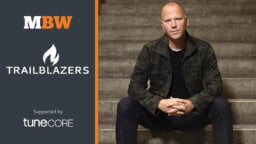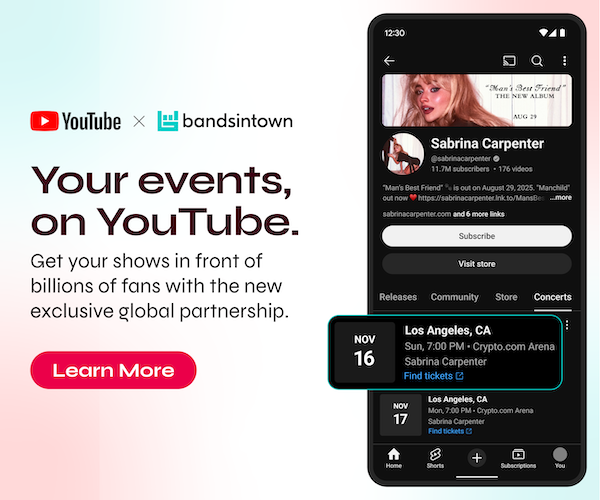Trailblazers is an MBW interview series that turns the spotlight on music entrepreneurs making waves in their local markets, who have the potential to become the global business’s power players of tomorrow. This time, we speak to Vinod Bhanushali, the founder and CEO of Hitz Music. Trailblazers is supported by Believe.
Experts in the global music rights industry are well aware that, in the future, India is only going to become more and more important to the bottom line of the business.
Take Goldman Sachs, whose latest Music In The Air report is particularly enthused about the prospects for India’s currently-embryonic music streaming subscription market.
Notes Goldman: “We see a huge opportunity in India in the long run, a market that has attracted a number of competing music streaming services (JioSaavn, Gaana, Airtel Wynk, Spotify, Amazon Music, YouTube Music etc.) and that counts 200 million MAUs [Monthly Active Users] but with only a paid penetration of 1% on our estimates in 2021.
“However, we note that telecom operators in India provide free music streaming services (through their captive apps; in most cases ad-free) to a large proportion of their subscriber base as a retention strategy, resulting in high competitive intensity for independent paid music streaming platforms.”
Focusing on the commercial potential of India, however, doesn’t reveal much about the market’s current thriving industry – nor the superstars that are being springboarded to fame by YouTube in particular.
Enter Dhvani Bhanushali. Having made her name as a ‘playback’ singer, in 2020 Dhvani became the youngest ever Indian artist to have a track surpass a billion streams on YouTube.
That track, Vaaste – released via T-Series – now has in excess of 1.4 billion streams on the video platform.
Dhvani has since successfully built on her smash hit: her channel currently has over 3.2 million subscribers on YouTube, while she has over 7 million monthly listeners on Spotify – with over a million of them in Mumbai alone.
Still just 24 years old, Dhvani isn’t the only talent in her family.
Her father, Vinod Bhanushali, is a successful producer in India (including his work on his offspring’s music).
He was the long-time President of global media marketing, publishing, and content acquisition at T-Series, but quit last year to make a bold entrepreneurial move.
In Q1 2022, Vinod launched his own independent record company – Hitz Music – unleashing new songs from Dhvani Bhanushali, while also releasing a Bollywood soundtrack album, Janhit Mein Jaari under the Hitz Music banner.
Hitz music is also working with a string of other artists (Yuvan Shankar Raja, Dhvani Bhanushali, Stebin Ben, Ikka, Palak Muchhal, Kanika Kapoor, Neeti Mohan, Nakash Aziz, Qaran) and others to release their independent music.
In addition, the company says it will soon be “launching a property” wherein they will bring various artists together like Shaan, Ankit Tiwari, Javed Ali, Asees Kaur, Akhil Sachdeva, Mohd. Irfan, Jyotika Tangri, Saaj Bhatt to name a few.
Here, Vinod Bhanushali gives his unique view of the Indian market, and predicts an even brighter future for his daughter, Dhvani, than we’ve seen to date…
How did you begin working with Dhvani, and what have been the key steps in her development as an artist so far?
Dhvani started singing in a choir back in school and participated in college festivals and I heard some of the songs. Looking at that I decided to give her an opportunity in a singing career.
We started shooting some versions of the songs and after a couple of years uploaded them on YouTube. Seeing the number of likes and followers, she got trained in music – and after finishing college she did her first video with the artist Guru Randhawa called Ishare Tere.
The rest is history. The song has garnered 581 million views on YouTube to date.
There is no denying the scale of her popularity: those YouTube numbers are huge Who is the audience streaming Dhvani’s music to that level, and what does that tell us about the modern industry in India?
Her popularity increased with Ishare Tere and then she worked on Leja Re [now on nearly 900 million YouTube views].
But her biggest track in India has been Vaaste which is now at 1.4 billion views. This song was released in 2019 and was included in the [global] Top 200 Videos on YouTube as a Hindi pop song.
So, since the start of her career, she has been extremely popular. The majority of her audience is in the age bracket of 13-25 years old. But when we did some analysis, we have had people who are [older] listening to her as well.
“India has one of the largest user bases as far as social media is concerned.”
Interestingly, she has a balanced interest amongst male and female [fans], and is not skewed towards one gender.
In the modern music industry, if you have talent and you [want a] showcase, it is very important to focus on marketing strategies. That’s thanks to the various digital platforms and the digital age, that help you to reach out to a wider audience and you can grow your fan base from there and be a star.
India has one of the largest user bases as far as social media is concerned. That combined with the growing audiences on audio and video music services, means your reach is nearly unlimited. With the right marketing strategies, sooner or later, your talent will be visible and heard.
Does that level of popularity translate into good earnings in 2022, or is there still some way to go for Indian artists?
Today, you have a lot of options with streaming sites where you can upload your music – for example on YouTube – and get paid.
Once you reach a certain popularity level as an artist today, you have options to work with a record label that pays like an artist [advance], or work with a digital music company, either for your music distribution or artist services. This allows artists to earn future royalties, which is an added advantage.
“We are now seeing more and more artists making money from digital music – something which was limited to top / established artists before.”
We are now seeing more and more artists making money from digital music – something which was limited to top / established artists before.
We see many artists who started creating a successful fan following on digital music stores first, then started making revenues from it, and eventually created audiences for their live [concerts]. Also, we have seen the trend of collaborations with various artists as [India is] a huge market and everyone wants to get noticed in the industry.
Dhvani performs both non-film and film music in India. Is it true that non-film music is becoming more popular amongst the younger generation? How is that affecting the industry?
Dhvani has been a pop singer and her genre has been pop music since the beginning. She’s the youngest pop star in India to reach 1 billion views on YouTube with Vaaste, which garnered a wide fan base.
Irrespective of non-film or film music, her track was a pop song that got immense popularity with the current generation as they love to see the artist perform, very similar to the West with the likes of Selena Gomez or Justin Bieber or Dua Lipa who have strong followings.
“We think that in a market like India, both non-film and film music will co-exist and grow in their own ways.”
We have seen the rise of young pop stars in India too, especially from Punjab, who have got massive popularity like Guru Randhawa, Badshah and AP Dhillon.
Non-film music is on the rise and as mentioned is making many local stars. Many of these stars, therefore, don’t really depend on film music to get started or continue their musical journey.
We think that in a market like India, both non-film and film music will co-exist and grow in their own ways. But yes, film music’s overall market share has dropped. However, [that trend] will [plateau] at some point allowing both forms of music to co-exist. There is a demand and appetite for both forms of music in India.
India has become a key global market in recent years but hasn’t yet broken into the IFPI‘s Top 10 markets in terms of trade revenues. Do you see this changing in the future? Can India become a Top 3 market in your view, and if so, what will need to happen to get it there?
It certainly can be a Top 3 market. India has already become a key global market and that’s one of the reasons for the streaming giants like Spotify or Apple Music coming to India. We have seen the growth of music tech companies like Believe in India too, thanks to the massive population and diversity and the younger crowd.
Unfortunately, from the economy side, we still have a long way to go and a need to move to a subscription model. The advertising rates in India (RPM) are lower compared to mature markets (currency values), and that’s where the challenge lies.
But in the years ahead, a change is bound to happen – as soon as we see better subscription base pick-up, education to the user community and more spending on advertising by brands (we still have large advertising spends on traditional media- print, TV, Radio).
But the year-on-year growth on digital is already encouraging,
How has Spotify’s launch in India changed the business there – if it has – in your view?
Undoubtedly, a streaming platform like Spotify has changed the music business in India. It has helped [users] navigate with ease – the kind of content that you consume or [is recommended to you] is qualitative. Spotify’s support to the artists, being in the market for so many years is commendable.
Thanks to their launch in India, we are seeing a lot of collaborations and this trend will continue as global artists want to explore the Indian market as well. That’s a massive trend.
Also, now we have a market with many services and we are seeing innovations, marketing and education from services to attract users for digital music consumption. There’s a good competition going on.
What is the biggest challenge in the market for a company like yours today, and how can this challenge be overcome by yourself and the industry?
I do not see a challenge in the market as such. The opportunity is there to explore further, as we are a diverse country with a lot of talent left to delve into.
When we launched HITZ, we collaborated with the big names in the industry, and it was quite successful. When we work with singers and composers, they are quite happy with the support from our label. We believe in freedom for artists, so right now we are in a very happy space and see ourselves growing.
There is a craze at the moment for massive companies to pay massive prices for the song catalogs of classic Anglo/American artists (Bob Dylan, Sting, Neil Diamond etc.). But some suggest the bigger future is actually for music that speaks to streaming’s fastest-growing audiences in their own languages (across Latin America, Africa, China etc.). What’s your view, and how could that future affect the value of companies like yours?
As an Indian label, we are quite focused on Indian artists and composers; that is how we have built up our value in the market. We already have a strong user base: there are 135 crores (1.3 Billion+) people [in India], out of which 65% consume Hindi film music or pop songs.
“I agree that the future is moving toward local markets and not global markets, which is why our focus is going to be on building a stronger local catalog.”
We want to continue our journey to build artists via good music, and focus on our local market and local artists, to build a strong catalog.
I agree that the future is moving toward local markets and not global markets, which is why our focus is going to be on building a stronger local catalog. With the market growing, valuations we see of catalogs [in India] today may mean nothing. Wait until India becomes a Top 10 market!
Which one thing would you change about the modern music business and why?
At this point, I am not sure if it is right to say that we would like to change anything as such. But in the modern music business, we are striving to bring about a change with respect to fairness to artists who are also composers – not only singers or lyricists.
Whenever [artists] produce [a track] which becomes a massive hit, they should be given a fair share. Along with this, there should be a proper royalty structure in place with integrity. For labels [like ours], we see a lot of music being used but the payment does not [match up] with all rationality. Consumption of music should be paid and not free.
Tell us something that would surprise people in the industry about your company and its business.
For Hitz Music, our main vision has been the freedom of artists with all fairness and integrity. We neither sign up any artists exclusively, nor charge them fees on their performance. Basically everyone involved – including lyricists and composers – gets a fair share.
We give fair marketing promotion and support to the songs we work with. As individuals, we have created value in this market over the years and that’s why we have the top composers working with [Hitz], the likes of Javed Ali, Asees Kaur, Neeti Mohan and Dhvani Bhanushali – and we are in talks with Honey Singh for his compositions as well – just to name a few. As a label, we want to build a transparent and equitable business model; there is a real need for that in India.
What’s your ultimate ambition for your business and for Dhvani, and how will you get there?
Dhvani is a hard worker with immense talent. The kind of fame she has, she earned; the fan base she has built so far purely reflects all her effort, and being persistent in the music industry.
We will continue to support her songs and I am sure she will make the music fraternity proud of her success.
We believe in creating good music supported by the right marketing strategies, and in learning and adapting as we go. We keep it simple and stay fully involved.






